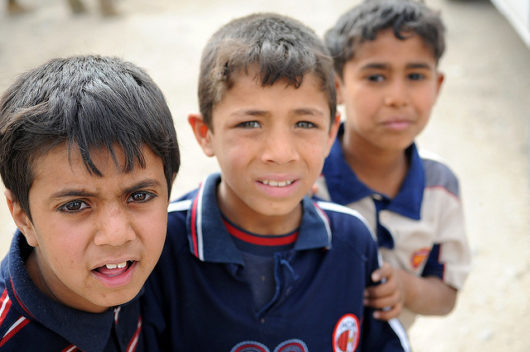Top 10 Facts About Living Conditions in Iraq

Decades of war and conflict have left their mark on Iraq. The lack of stability in the region has made the productive investment a challenge and limited private sector consumption and growth. Living conditions in Iraq are often strenuous and many people struggle with poverty, unemployment and malnutrition.
The struggle has marked the recent past for many Iraqis, however, despite setbacks, the country is trying to rebuild itself. In May 2018, the country had its first national election since the war with ISIS, instilling hope in many people that Iraq is on it’s way to political stability. The hope is that times of war are in the past and a new Iraq lays ahead. In the text below, top 10 facts about living conditions in Iraq are presented.
Top 10 Facts About Living Conditions in Iraq
- Between 2014 and 2017 the Iraqi government was engulfed in civil war with the Islamic State (ISIS). In December 2017, the Iraqi government announced that all territory captured by ISIS during the war had been liberated. However, the effects of the war were tragic for the people. For example, in the period between January 2014 and October 2015, nearly 19,000 civilians were killed and about 3.2 million people were internally displaced.
- As a result of the fighting and destruction during the Iraqi Civil War, millions of civilians were displaced from their homes, lost their jobs and were stripped of many other assets key for financial security. Reflective of this situation is the disproportionality of unemployment rates in areas most affected by ISIS (21.6 percent) compared to the rest of the country (11.2 percent). Additionally, UNICEF released a report this year warning that one in four children in Iraq is in poverty and four million in need of assistance as a direct result of the war.
- On September 25, 2017, the Kurdistan Regional Government (KRG) passed a referendum establishing independence from Iraq. In response to the results of the referendum, the federal Iraqi government instructed the KRG to nullify the results of the referendum as well as withdraw KRG military forces from the city of Kirkuk. On Oct. 16, Iraqi forces retook previously Kurdish-controlled territories forcing thousands of Kurdish families to flee their homes and escape the approaching Iraqi federal forces.
- In May 2018, Iraq held its first national election since the ISIS takeover in 2014. Although the fact that the elections were held is positive, voter turnout was the lowest since the country’s first democratic election in 2005, coming in at 44.5 percent. Additionally, the vote had to be recounted in June due to concerns over serious violations in the initial vote count. Four months after the elections, the winning parties are still in negotiations over forming the next government.
- In recent years, rainfall has been increasingly sparse throughout Iraq. Lack of rainfall, as well as dam construction upstream in Turkey and Iran, have significantly reduced water levels in the Tigris and Euphrates rivers which has consequential effects on Iraqi agricultural and hydroelectric outputs. As an added concern, the increasingly dry seasons have caused water salinization making it unusable for farming and worsening living conditions in Iraq.
- Results gathered by the World Food Program reveal that 53 percent of Iraqi residents are vulnerable to food insecurity. Faring worse than national averages are Iraqis who have been internally displaced by the civil war. Results show that 66 percent of internally displaced people are susceptible to food insecurity.
- Life expectancy in Iraq is reported to be 58.7 years for men and 62.9 years for women. In recent years, health care for Iraq’s population has been weakened due to warfare and economic sanctions. As Iraq’s GDP has shrunk in the recent past so has its public expenditure on health care. Health services have deteriorated and routine shortages in drugs and other supplies followed.
- Iraq has an incredibly young population. Forty percent of the population was born after the U.S. invasion in 2003. This youthful group of civilians poses unique challenges and benefits to the country. To support this population the government will need to invest in education and other social services to maintain suitable living conditions in Iraq. In the upcoming years, the Iraqi labor force is expected to increase greatly, offering up a significant economic opportunity for the country.
- Iraq has free of charge, compulsory primary education for six years. In comparison to other countries in the region, Iraq has been notable for its commitment to educating boys and girls alike. As a result of this egalitarian approach to public education, Iraq has an overall literacy rate of 80 percent.
- Compared objectively to women’s freedoms globally, Iraqi women undergo certain practices that have been deemed suppressive and unequal in many countries. More than 24 percent of Iraqi women claim to have been married before the age of 18, indicating a very high rate of child marriage. Additionally, 8 percent of women are claimed to have been victims of female genital mutilation. These data and other statistics rank Iraq 123 out of 189 countries on the U.N.’s Gender Inequality Index.
When looking at Iraq, one can see a country set back and hurt by decades of conflict. Currently, though, the country is not at war and the national election this past May marked the progress of the living conditions in the country since the chaos of a year ago. However, a voting recount and partisan negotiations have made the results of the election vague and uncertain.
Reflective of the frustration of this election and the futile optimism of the Iraqi people is a quote from Hawla Habib, a professor at Mustansiriya University in Baghdad explaining that “all Iraqis care about their nation, it’s just that many are too tired to think anymore.”
– Clarke Hallum
Photo: Flickr
